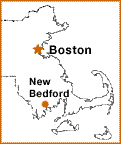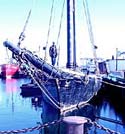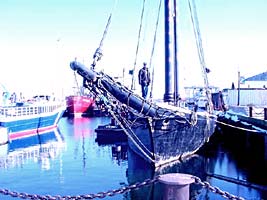Live far away from Massachusetts or lack school funds to take a field trip? Take your class on a virtual field trip of Underground Railroad sites in New Bedford, Massachusetts.
The Underground Railroad in New Bedford, Massachusetts

The Underground Railroad in New Bedford, Massachusetts
It is estimated that from 300 to 700 hundred fugitive slaves lived in New Bedford between the mid-1840s and 1860. In a city whose official population of color hovered around 1,000 people, the number of fugitive slaves in New Bedford was large even by the more conservative estimate.
They had come to the city by the Underground Railroad, neither "underground" nor a "railroad" but a rather a loose network of assistance to persons escaping American slavery. This network was "underground" only in a figurative sense. The activities of runaways and those those who aided them were kept as secret as possible, and this very secrecy makes it difficult to estimate precisely how many Southern slaves fled to the North and to Canada between the 1780s and the Civil War. Surely they number in the tens of thousands. In the 1850s alone, when the passage of the Fugitive Slave Act gave Federal sanction to Southern slave owners' efforts to retrieve escaped slaves, more than 20,000 are believed to have made their way into Canada.
Fugitive Slaves Came to New Bedford

Fugitive Slaves Came to New Bedford
New Bedford was attractive to fugitive slaves for four main reasons. First, whaling, the third most profitable industry in Massachusetts at mid-century, had made the city both wealthy and in constant need of labor at a time when the higher wages and steadier work that factories offered - exclusively to white men and women- had begun to draw workers away from whaling ships and wharves. The maritime trades had historically been more welcoming to black participation than other industries, and whaling may have been the most open of all.
Ernestina
Second, the city was an active part of an extensive coastal trading system. New Bedford merchant vessels carried oil, whalebone, apples, hats, shoes, and other food and factory products to Southern ports and the West Indies and returned with cotton, naval stores (lumber, turpentine, pitch, and tar), flour, rice, beef, and pork. Fugitive slave narratives document that runaways took advantage of this commercial network. Often aided by crew members and dock workers of both races, they stowed away amid ships' cargoes; sometimes sympathetic vessel captains brought them North. Many, like Frederick Douglass, traveled over both land and water to New Bedford, while others, like Joseph M. Smith, traveled entirely by vessel to the port.
Third was New Bedford's "liberal spirit," as U.S. Senator Charles Sumner called it. Quakers, who controlled the city's political and economic life into the 1820s, had taken an early stand against oppression and any form of forcible resistance, an inclination that remained among a significant group of the city's antislavery leaders until the Civil War. Though some early Quakers had held slaves, individual Quakers, and many Unitarians, who had once been Quakers, were among the city's staunchest abolitionists.
People of color in New Bedford

People of color in New Bedford
Finally, the city was home to a large population of color. In 1850, people of color were 6.3 percent of the city's population, a greater proportion than prevailed in Boston, New York City, and Philadelphia. Between 1850 and 1855, when the threat of capture after the Fugitive Slave Law had diminished the black population of many citites, New Bedford's actually grew, from 6.3 to 7.5 percent of the total population. And fully 30 percent of New Bedford's people of African descent in 1850 were born in the South, compared to 15 percent of New York's black population and 16 percent of Boston's at the time.
This African-American community was active in antislavery reform since at least the 1820s. It founded the city's antislavery society in the fall of 1833. When Frederick Douglass arrived in 1838 he found New Bedford's people of color "much more spirited than I had supposed they would be. I found among them a determination to protect each other from the blood-thirsty kidnapper, at all hazards." In 1855 he wrote: "No colored man is really free in a slaveholding state. He wears the badge of bondage while nominally free, and is often subjected to hardships to which the slave is a stranger; but here in New Bedford, it was my good fortune to see a pretty near approach to freedom on the part of the colored people."
Job Opportunities for People of Color in New Bedford in the late 1840s.

Job Opportunities for People of Color in New Bedford in the late 1840s.
You are looking at what was once George Howland's wharf and later Merchants' Wharf, one of the more than twenty slips and wharves in New Bedford in the late 1840s. Both whaling and coasting vessels were repaired and outfitted for their voyages at these wharves. Here fugitives who escaped slavery on coasting vessels first set foot on free soil. And runaway slaves who came to labor-hungry New Bedford stepped from these wharves onto whaling vessels. At sea from 16 to 60 months, these men of color were virtually assured that they would not be returned to slavery.





